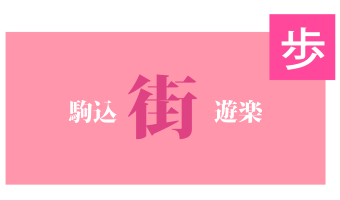|
C. 験担ぎ 一富士二鷹三茄子ルート / Genkatsugi (Superstitions) Ichi-fuji, Ni-taka, San-nasubi Route |
||
|
縁起のいい夢のたとえである富士山、鷹、茄子。江戸時代の川柳に「駒込は一富士二鷹三茄子」と詠まれ、世に広く知られていました。 日枝神社からはじまる験担ぎのルートは、かつて『江戸名所花暦』にも桜の名所と紹介された根津権現までの道です。願いを携えて、江戸の散策をお楽しみください。 |
||
|
Mt. Fuji, hawks, and eggplants when seen in dreams are said to bring good fortune. There is a senryu "Komagome wa, ichi-fuji, ni-taka, san-nasubi" from the Edo period that is widely known in Japan. Enjoy the genkatsugi route that starts at the Hie Shrine up to the Nezu Gongen Shrine that was stated to be a sightseeing spot for cherry blossoms in the "Edo meisho hanagoyomi (flower calendar of famous places in Edo)" with hopes for good fortune. |
||
|
|
||
|
|
||
|
|
||
|
|
||
|
|
||
|
|
||
| 周辺の切絵図を見る | ||
| ①日枝神社 / Hie Shrine | |

『江戸叢書:12巻. 巻の四』 |
日枝神社は、東から燦々と輝く陽を浴びるということで、江戸時代には朝日山王宮と呼ばれていた。高台にあり、風光明媚なこの地のことを『江戸叢書 : 12巻. 巻の四 「二十九 染井の郷殿中朝日山王宮」』には、次のように表されている。 [原本を読む]
Hie Shrine was known as the Asahi Sannouguu during the Edo period due to the building being gifted with rays of brilliant sun shine from the east. It is positioned on high ground and the scenic location is described as seen below in the "Edo sosho, vol. 12-4 'Somei no Asahi Sannouguu'".
[Read manuscript] |
| ②富士浅間社 / Fuji Sengen Shrine | |

『江戸名所図会. 第3』135ページ |
富士浅間神社は、この地域の富士信仰の拠点である。境内には江戸時代、関東地方を中心にさかんにつくられた富士塚のうちの一つがあり、地元の人たちに親しまれている。 富士浅間神社の祭神は、「さくら」の語源とされる※木花咲耶姫命(このはなさくやひめのみこと)で、美人には嫉妬深く、きれいな人がお参りをすると雨を降らせるとのいいつたえがある。 下の挿絵には、富士浅間神社の富士塚を参詣する人たち(富士山に登りたくても登れない女性や老人)が描かれている。六月一日は山開きで前夜から多くの人で賑わったという。 富士詣での土産として、人気を博したのが麦藁細工の蛇で、当時、疫病の予防によいと評判であった。 ※諸説あります。
Fuji Sengen Shrine is a base for worshipping Mt. Fuji of that region. A Fujizuka (small mounds representing Mt. Fuji), of the many created in the Kanto region, is installed in the shrine, and is popular amongst the locals.
The worshipped deity of Fuji Sengen Shrine is Konohanasakuyahimenomikoto, known as the origin of the term "Sakura"*, who is also told to be intensely jealous, and makes rain fall when a beautiful person visits the shrine. In the below illustration, you can witness a scene of people visiting the Fujizuka of the Fuji Sengen Shrine (women and the elderly who want to climb Mt. Fuji but couldn't). June 1 is the first day of the mountain-climbing season and it is said that the site was crowded with people on the previous night. A popular souvenir on the Fuji pilgrimage was straw work snakes. They had a reputation to ward off plagues at the time. *There are various theories. |

『江戸名所図会. 第3』136ページ |
| ③駒込神明宮 / Komagome Shinmeigu | |

『江戸名所図会. 第3』132ページ |
創建は文治5年(1189)と古く、源頼朝公奥州藤原泰衡征伐の時、霊夢のお告げがあり神明を祀るとある。 江戸時代は、鷹匠屋敷の前にあった。 挿絵をみると、駒込神明宮の鳥居の前には、「此辺芝生」とある。『江戸切絵図』には「御用地 神明ノ原ト云」ともあり、幕府の芝生生産地と思われる。 駒込神明宮の周辺は、田畑が広がっており、江戸中心地への野菜の供給地として、なす、大根、ごぼうなどを栽培していた。江戸時代には、駒込なすとして庶民に親しまれた。
Established during the Bunji period 5 (1189), it is said that during the battle of Oshu against Fujiwara no Yasuhira, Minamoto no Yoritomo was told to worship a deity through a revelatory dream.
It was established in front of the falconer house during the Edo period. In the illustration, there is a lawn in front of the Torii of the Komagome Shinmei Shrine. In the "Edo Kiriezu", it is also referred to as the "Goyouchi Shinmeinohara", and it is believed to have been the production site of lawns during the Bakufu period. Around the Komagome Shinmeigu, you will find fields that acted as suppliers of vegetables including eggplants, Japanese white radishes, and burdock for the industrial center of Edo. During the Edo period, the eggplants were popular among the locals as Komagome eggplants. |
| ④諏訪山吉祥寺 / Suwayama Kichijoji Temple | |

『江戸名所図会. 第3』130ページ |
諏訪山吉祥寺には、表門から桜が植えられ、挿絵に描かれた様に奥深く、本堂へと通じている。ここは禅宗の栴檀(せんだん)であり、挿絵には学寮という文字が数箇所見られる。 手前の道は日光御成道であり、左に行くと駒込を過ぎ、西ヶ原一里塚を経由し飛鳥山に抜ける。
At the Suwayama Kichijoji Temple, there are cherry blossoms planted on the lengthy path from the front gate up to the main shrine. The shrine is a Sendan for the Zen sect and is described in the illustration as a dormitory.
The path to the front is the Nikko Onari Michi and going left, you will pass by Komagome, go through Nishigahara Ichirizuka, and exit to Asukayama. |
| ⑤駒込大観音 / Komagome Oogannon | |

『江戸名所図会. 第3』127ページ |
この寺は光源寺といい、駒込の大観音として知られ、多くの寺院が密集する寺町のなかにある。 巨大な観音様が2階から、下をみつめている。旅人と思われる2人が、びっくりした様子で上を見上げ、指さしている。 観音様の顔が拝めるように、窓をあけて観音開きにするなど、寺院建築としては非常に珍しかったといわれる。
This temple is the Kogen Temple and the Kannon is known as the Daikannon (great Kannon) of Komagome. It is located in a temple town where several temples are clustered together.
A large Kannon statue gazes downwards from the second floor. In the illustration, you will find 2 surprised people that are believed to be travelers looking up and pointing upwards at the statue. It is said that that Kannon biraki (hinged double doors) structure that allowed visitors to view the Kannon statue's face was an unusual style for temple architecture. |
| ⑥根津権現社 / Nezu Gongen-sha | |

『江戸名所図会. 第3』116-118ページ |
根津神社は俗に根津権現といい、日本武尊(やまとたけるのみこと)が東征の際、千駄木の地に創祀したといわれる古社で、太田道灌(どうかん)が社殿を再建した。 挿絵をみると、惣門前に見える水路は不忍池に流れる。境内には池があり水が豊かな土地のようだ。小さな丘の斜面には、江戸時代のころからつつじが植えられ、つつじが丘と呼ばれ人々に親しまれた。 また、『江戸名所花暦』によると、この地が桜の名所であるとの記載があるが、世間では“曙の里”として、参詣客が茶屋に立ち並び、朝方から賑わっていたと伝えられている。
Nezu Shrine is also known as the Nezu Gongen is an old shrine established in Sendagi when Yamato Takeru no Mikoto traveled eastwards. The main shrine was rebuilt by Ota Dokan.
"In the illustration, the waterway that is visible in front of the Soumon (castle gate) flows into the Shinobazu Pond. There is a pond within the grounds indicating it is rich with water. There are azaleas that were planted during the Edo period on the slope of the small hill, earning the spot the name Tsutsujigaoka (hill of azaleas)." Also, according to the "Edo meisho hanagoyomi", this location is a famous spot for cherry blossoms, but it is also described to have had a teahouse crowded with visitors from early in the morning. |

 前の画面へ戻る
前の画面へ戻る